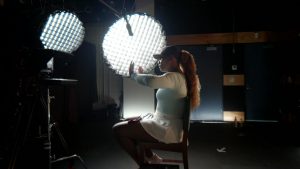US Open 2020: ESPN taps hsc.tv for No-Contact Studio
Story Highlights
At the U.S. Open Tennis Championships, New York City-based production company hsc.tv is producing specialty portraits and player interviews that are being used for broadcast elements and stories on ESPN, as well as on social media.bWhile the ESPN U.S. Open assignment is a recurring one for hsc.tv, this year the parameters are decidedly different.

Serena Williams inside ESPN’s contactless studio at the US Open, built by hsc.tv.
“We knew the feature storytelling at this year’s U.S. Open would be unique and challenging,” says hsc.tv partner and Sports Emmy award-winning cinematographer Bryan Brousseau. “We wanted to create a safe interview space where the players would be alone in a room and have no contact with crew.”
hsc.tv wanted to create a no-contact interview set where it would control cameras and lighting without being in the set. Panasonic AU-EVA1 and Panasonic VariCam LT cameras on Kessler pan tilt remote heads, and Tilta focus controls to control new prime lenses were a key component along with a remotely controlled teleprompter system.
“The cameras gave us the 10bit 4K-sensor quality we wanted,” Brousseau explained. “For lighting, we dmx controlled our lights using bronControl APP with F160 LED fixtures in Para 133 and Para 88 umbrellas. For our custom TWZM practical lights, we used Leviton D4DMX-MD5 dmx dimmer packs to a hard-wired dimming board.”
hsc.tv video technician Rick Elders (winner of a Sports Emmy for ESPN technical team remote at the U.S. Open last year) says: “Our goal was to interview players remotely through a Zoom call but we wanted to use Panasonic’s professional cameras to give the interviews a great look. Both Panasonic cameras have LAN Ethernet capabilities that were key to controlling camera settings remotely through Panasonic’s ROP app.”
Elders says ESPN was able to convert SDI to HDMI through a Shogun Inferno that fed into Zoom.
“We then mirrored our iMac display into a teleprompter through HDMI so players can communicate directly with ESPN talent,” he says. “We were able to use Belkin Ethernet to iPhone Thunderbolt adapters for a hardwired (more reliable) solution compared to Wi-Fi.”
Describing the project audio, Sound Mixer Eric Diebner says the first and foremost aspect of this new ‘zero-contact’ set-up is the ability for the player and remote producer to have clear and tangible audio.
“The main challenge to think about is the player has to hear the producer but not have that audio bleed into their mic,” adds Diebner. “I decided to go with the Schoeps CMIT 5U for its supercardioid polar pattern while providing low off-axis coloration for natural sound at all angles. It’s important for the mic to be placed–not moved–and sound great. The Schoeps did a great job.”
For audio routing the Schoeps was fed into a computer audio interface which then went into the Zoom meeting. This gave the ability to anyone on the meeting to hear the tennis player loud and clear.
“In order to properly distance ourselves from the players, there was no way the laptop microphone would pick up the player appropriately,” says Diebner. “The second challenge was feeding the producers audio to the player and for that I used a high-quality JBL speaker to control the volume. This allowed me to control the amount of audio bleed from the producer into the Schoeps. I also fed a little outside speaker for the players’ coaches and entourages.”
ESPN has exclusive live coverage with daily marathon telecasts from the U.S. Open that began Monday, August 31, and will conclude with the Women’s and Men’s Championships, Saturday, Sept. 12, and Sunday the 13th, respectively. Between 136 hours on television and every match on the ESPN App, all courts from the USTA Billie Jean King National Tennis Center will be covered.
For more about the Emmy Award winning production company, visit www.hsc.tv.
